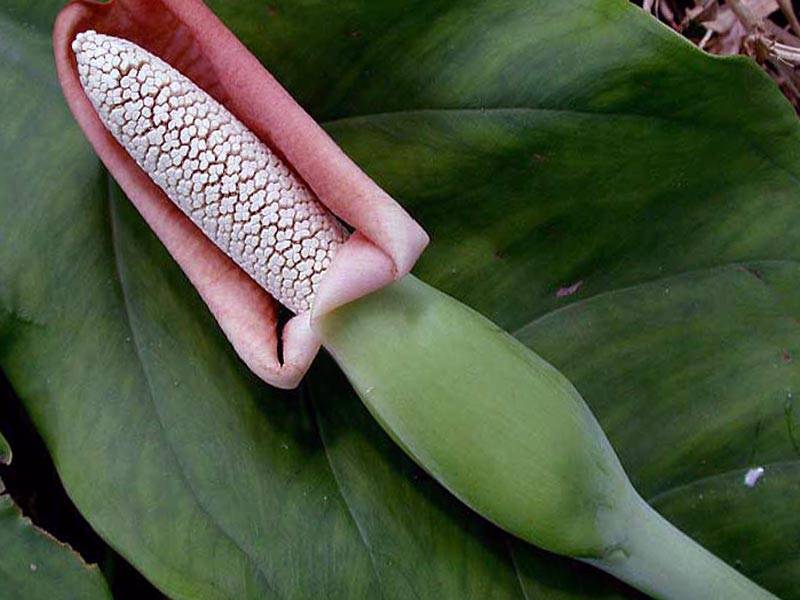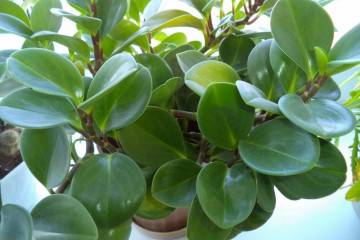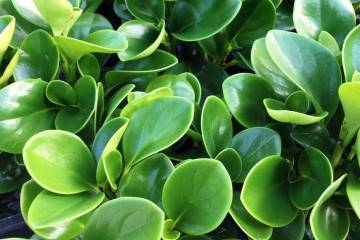Syngonium - home care
Content:
Syngonium will help lovers of house plants to create tropics in a city apartment or a country house. A spectacular vine with juicy leaves, with proper care, will delight households and create a favorable atmosphere.
What does it look like, which family it belongs to
The homeland of the plant is considered to be South America. Syngonium is a bright representative of the numerous aroid family, numbering more than 30 species. In Latin, the name is consonant - Syngonium.
The appearance of the plant is an evergreen vine with a flexible green stem, on which multiple air roots are located. Vine houses grow up to one and a half to two meters, dotted with luscious foliage on long cuttings.
Foliage can be of various shades of green: from whitish to saturated; there are variegated colors: spotted, shaded, sinewy.
Indoor syngonium blooms extremely rarely, but if this happens, the plant will delight with an ear surrounded by a light green blanket, which will turn red over time.
Those wishing to grow syngonium are interested in whether it is possible to keep an unusual plant at home, and what atmosphere the flower creates in the house.
A tropical guest is believed to have a positive energy and is able to have a healing effect. A flower is useful when surrounded by people suffering from gastrointestinal disorders.
Signs attribute to the syngonium the ability to change life for the better - this is due to a change in the growth process. Therefore, it is advised to start it at home for people living in the past.
The third belief is associated with the ability to get rid of unpleasant dreams, keep a pot of vines well in the bedroom.
Syngonium: home care
Growing juicy stems at home does not require special skill, simple adherence to conditions and rules will help to achieve success. Five basic rules that will allow you to provide Syngonium flower care at home.
The first rule is illumination. Tropical vines love partial shade; direct rays are destructive. The right choice would be the premises located on the west, east, north sides. The more scattered light, the more variegated the color can be. For uniformly faded sheets, more shade is required.
The second rule is temperature. In summer, it is better for her not to exceed 24 degrees Celsius, in winter - 18 degrees. The minimum threshold is 10 degrees for a short time.
The third rule is humidity. The air around the plant should be humidified, in summer it is better to spray the leaves once a day, in winter to remove the pot away from the heaters. Soil moisture is provided by irrigation. It should be carried out when the topsoil dries up. The flower does not like stagnant water in the pan and excessive watering. It is better to use water at room temperature.
The fourth rule is soil. The optimal proportion - mixed in equal proportions of leaf and turf soil, sand, peat mixture. It is important to ensure good drainage from expanded clay or other sorbents. Florists add bone meal and activated carbon to the pots.
The fifth rule is feeding.Liquid mineral fertilizers will be useful in the warm season once every two to three weeks. In addition to vitamin supplements, pinching is done to vines for greater bushiness. Above the sixth to seventh leaf node, young shoots are carefully cut off with the arrival of spring.
When and how it blooms
The syngonium flower resembles a calla - the central core is surrounded by a petal, like a blanket. At the same time, the stem of a tropical plant is more reminiscent of an ear of corn of light shades, the "blanket" initially also has a whitish color, eventually acquiring shades of red. It is almost impossible to see this at home - syngonium blooms mainly in the wild, pleasing to the eye from May to October. In urban conditions, vines are grown for the sake of juicy greenery and a favorable atmosphere.
Pruning
There are several ways to form a crown. The easiest way is to hang the pot with the plant in the flowerpot as high as possible, then the stems will grow up to almost two meters in length and hang beautifully to the floor. There are tricks for vertical planning.
A moss tube can act as a support for the vine. With the next transplant, it goes deeper into the center of the pot at the stage of laying the drainage. After the first third of the soil is filled up, the plant is transferred, the soil is filled up around the circumference. Over time, the stems will twist around the resulting support, creating a decorative appearance of the flower.
You can make a bushy plant from a climbing plant by forming a crown. Cutting off shoots at the level of the sixth leaf leads to the formation of lateral shoots, for which the procedure can be repeated. Thus, a compact bush for small spaces is formed.
How does it multiply
Gardeners cultivating syngonium know that flower reproduction is possible in two ways:
- When cutting, shoots are cut off from the tops or stems up to 15 centimeters long, while several internodes with air roots should remain. To propagate the stalk for the formation of full-fledged roots, it is necessary to place it in a glass with warm, settled water, in which a crushed tablet of activated carbon is mixed. The second option is planting in the ground from a sand-peat mixture and moss. In this case, the shoot must be covered with cling film to achieve a greenhouse effect. The dome is removed after full rooting. On an ongoing basis, shoots are transplanted into a container one or several pieces, if necessary, with an installed support for crown formation.
- Stem propagation is carried out in a similar way. A vine from a pot with the main plant is placed in a prepared container with soil. A segment with aerial roots is buried in the ground and fixed. Watering and feeding are carried out according to the standard scheme. On average, after ten days, the rooted shoot is cut off from the mother stem.
Transfer
Annual transplantation is necessary for young flowers. Adults move to a new container once every two to three years. The need for transplanting is determined by the roots that begin to peek out of the drainage holes of the pot. The new capacity is chosen a little more than the previous one. Syngonium does not like overly spacious pots. It is necessary to take care of the plant especially carefully after moving.
Possible growing problems
Syngonium is not a capricious plant, but some problems during cultivation can still arise:
- on syngonium, aphids, spider mites, thrips and scale insects can parasitize. To get rid of uninvited guests, insecticide treatment and disinfection of the premises are necessary, carried out at least once every one and a half weeks. It is important to mechanically remove insects from the plant before starting resuscitation procedures. To do this, use cotton wool or a sponge soaked in a neutral soap solution;
- the formation of dry brown foci on the foliage causes fungal infections. Treatment consists in cutting off diseased leaves and transplanting vines into fresh soil. Once every ten days, foliage and soil must be treated with phytosporin preparations;
- the appearance of yellow leaves may be associated with excessive watering, drafts, dry air, direct sunlight. After normalization of the microclimate, the plant takes on a healthy appearance.
Flower varieties
There are many types of syngonium in nature, most of which are suitable for cultivation at home with success. Popular types are shown in the table:
| Syngonium species | Description | Varieties |
| Syngonium leg-leaved | Whole young leaves will eventually be cut into 11-12 segments. The petioles grow up to 60 centimeters in length. Coloring, depending on the variety, is shades of greenery, variegated leaves, and the syngonium can also have a pink color. | Syngonium Imperial White Syngonium Butterfly Syngonium Pixie Syngonium Arrow Syngonium Neon Syngonium Panda Syngonium Confetti Syngonium Red Spot Syngonium Pink Spot Syngonium Macrophyllum |
| Syngonium auricular | The leaf blade eventually divides into three lobules, the leaves have ears in the form of ears, reaching 20 centimeters in length. The petioles grow up to 40 centimeters. | |
| Syngonium Wendland | It is similar to the ear-shaped syngonium, but differs in smaller foliage, not exceeding 10 centimeters in length. At the same time, the surface of the leaves is velvety, and the color is most often dark green. | |
| Syngonium broker | Easy to distinguish by color. Only in this species, the leaves have a brown-chocolate color and are covered with burgundy veins. |
The choice of the type of plant to grow at home depends on personal preference. All syngoniums equally favorably affect the "weather" in the house, have similar requirements for living conditions and care.





















